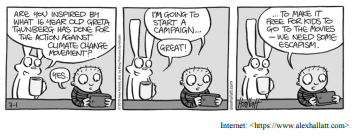Questões de Vestibular
Sobre interpretação de texto | reading comprehension em inglês
Foram encontradas 4.926 questões
The comic strip shows that, for the kid, going to the movies is a way of thinking about something other than climate change.
In the first box, the words in “action against climate change” work together as a way to define the “movement” to which the rabbit is referring.
The expression “16 year old Greta Thunberg”, in the first box, could have been correctly written as 16-year-old Greta Thunberg.
The rabbit is representing an adult who is scared by the action against climate change movement.
The expression “the increased burden”, which closes the second paragraph, refers to women’s difficulties and responsibilities that increase because of the climate crisis in agricultural countries.
The sentence “Across the world (…) resources” (second sentence of the second paragraph) can be correctly rewritten as In the whole world, women are more dependent on natural resources, even though they have less access to.
In the second sentence of the first paragraph, the word “livelihoods” refers to means of support or sources of money people need to survive.
The text states that the combination of gender inequality and climate change is the most serious problem humans face in current time.
Even though climate change increases risks for women around the world, women in poorer countries are faced with more severe scenarios.
Climate change can both worsen existing conflicts between nations and peoples as well as cause new ones.
According to the previous text, judge the item below.
The passage “periods of drought and erratic rainfall” (fourth sentence of the second paragraph) means periods when there is no rain and periods when there is too much rain.
When the author states “the whole thing is largely an afterthought” (second sentence of the last paragraph), it can be correctly inferred that environmental concerns are not being considered as important as “battles over territorial, political and historic rights” in Israel and the Palestinian territories.
In the excerpt “where 2.1 million Palestinians are crammed into 365 square km”, the use of the verb “crammed” emphasizes how very densely populated the Gaza Strip is.
The expression “desalination plants” (third sentence of the first paragraph) refers to aquatic vegetation that is able to take salt out of seawater.
In the first paragraph, the information between parentheses indicate the equivalent values in Farenheit degrees, for temperature, and in square miles, for length, which are usually adopted in the United States of America.
Temperatures in Israel and region have risen 1.5 °C more than in the rest of the world in the same period of time.
The Haarez newspaper has projected that sea levels in the region of Israel will be one meter high by 2050.
“– Listen, God love everything you love – and a mess of stuff you don't. (…) It always making little surprises and springing them on us when us least expect. (…) Man corrupt everything (…) He try to make you think he everywhere (…), you think he God. But he ain't. (…) I start to wonder why us suffer. Why us black. It didn’t take long to realize I didn’t hardly know nothing.”
(Adaptado de: WALKER, Alice. The Color Purple. London: The Orion Publishing Group, 1983.)
Assinale a alternativa que preenche corretamente as lacunas no trecho a seguir:
É correto dizer que o excerto apresenta aspectos linguísticos – que diferem dos observados na variedade padrão – como (i) _________, e que sua temática central é a (ii) ________.
(Adaptado de: https://www.peta.org/blog/guardians-of-the-galaxy-vol-3/. Acesso em 19/05/2023.)
Para a autora dessa crítica, o diferencial do filme está
(Adaptado de: https://atribecalledgeek.com/woe-to-the-colonizer-an-indigenous-perspective-of-wednesday/. Acesso em 12/05/2023.)
A análise do autor sobre “Wednesday” se apoia em
